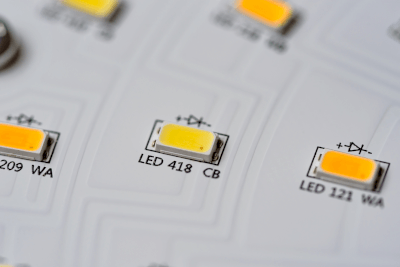What Is a Surface Mount Device (SMD) LED?

A Surface Mount Device (SMD) Light Emitting Diode (LED) is a type of LED device package that is mounted by soldering directly to a pattern on a printed circuit board without any insertion holes on the board.
In addition to the top-emitting type, there is also a side-emitting type that emits light from the side.
Compared to the old bullet-type LED packages, surface-mount LEDs are brighter and provide a wider illumination angle, are smaller, require less mounting space, and have higher heat dissipation efficiency due to the material and structure on the back of the element.
Uses of SMD LEDs
SMD LEDs are used in most general lighting fixtures such as ceiling lights, indirect lights, desk stands, and sensor lights because of their brightness and ability to illuminate a wide area.
They are also used in control panels and remote controls for digital cameras and video cameras because they can be mounted on the surface of the product.
SMD LEDs are also used in a wide range of other applications, such as automobile headlights, room lights, meters and other panels, LCD TV and LCD display backlights, and electric decorations.
Principle of SMD LEDs
SMD LEDs consist of 0.3mm square LED elements fixed to a lead frame, LED elements, and electrodes connected with bonding wire, and then encapsulated with resin such as epoxy or silicon.
Transparent epoxy or silicon resin is used as the encapsulating material to allow the light emitted by the LED elements to shine out of the package, but recently glass materials have also been used.
Silicon resin is used for LEDs for high-power products such as lighting fixtures and LCD backlights because of its slower rate of light transmittance degradation due to deterioration. Epoxy resins, which are said to degrade more quickly than silicone resins, are used in LEDs for low-power products such as indicators. Glass materials degrade even more slowly than silicone resins and have high reliability.
SMD LEDs are often used for general lighting applications, but lighting requires white light. Therefore, SMD LEDs for lighting purposes have a mechanism to obtain white light by mixing light from single-color LEDs. The main methods of producing white light are as follows:
Single-chip method: This method combines a blue LED with a yellow phosphor that emits yellow light when excited by blue light. Since blue and yellow are complementary colors, mixing them produces light that is perceived as white by the human eye. Because of its simple structure and high efficiency, this method is currently the mainstream. Another method is to combine blue LEDs with red and green phosphors to mix the three primary colors of light to obtain more natural white light.
Multi-chip method: This method combines blue, red, and green LEDs, which are the three primary colors of light, and requires a more complex circuit configuration because the lighting voltage varies depending on the LED color.